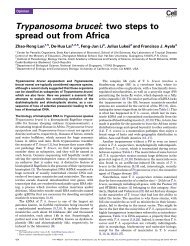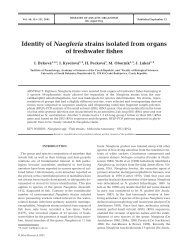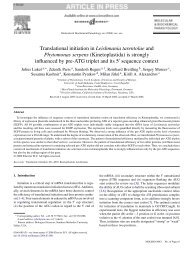Goussia Labbe´ , 1896 (Apicomplexa, Eimeriorina) - Institute of ...
Goussia Labbe´ , 1896 (Apicomplexa, Eimeriorina) - Institute of ...
Goussia Labbe´ , 1896 (Apicomplexa, Eimeriorina) - Institute of ...
Create successful ePaper yourself
Turn your PDF publications into a flip-book with our unique Google optimized e-Paper software.
134 M. Jirku˚ et al.<br />
Academy <strong>of</strong> Sciences <strong>of</strong> the Czech Republic,<br />
České Budějovice, no. IPASCR Prot. Coll.: P-2.<br />
DNA sequences: SSU rDNA available at Gen-<br />
Bank TM under the accession number ‘‘submitted’’.<br />
Etymology: The species is named after the<br />
German parasitologist Pr<strong>of</strong>. Dr. med. vet. Wilhelm<br />
Nöller (1890—1964), who had discovered <strong>Goussia</strong><br />
in anuran tadpoles for the first time, as a tribute to<br />
his significant contribution to the knowledge <strong>of</strong><br />
protistan parasites <strong>of</strong> amphibians. Nöller’s name is<br />
latinized to ‘‘Noeller’’ and the species name itself<br />
is created as its genitive form ‘‘noelleri’’.<br />
Remarks: Up to date there are two <strong>Goussia</strong><br />
spp. described from amphibians; G. hyperolisi<br />
from tadpoles <strong>of</strong> reed frogs H. viridiflavus in Kenya<br />
and G. neglecta from tadpoles <strong>of</strong> Pelophylax spp.<br />
in Europe. Morphological and morphometrical<br />
features <strong>of</strong> oocysts and sporocysts <strong>of</strong> G. noelleri<br />
and G. neglecta overlap and the two species<br />
cannot be distinguished from each other based<br />
on oocyst/sporocyst morphology (Table 1). The<br />
only differentiating trait is the divergence <strong>of</strong> SSU<br />
rDNA sequences. Sporocysts <strong>of</strong> G. hyperolisi<br />
(5.6—7.7 4.2—5.6) are somewhat smaller compared<br />
to G. noelleri (7.0—8.5 4.0—5.5). On<br />
the ultrastructural level, G. noelleri differs from<br />
G. hyperolisi by the apparent absence <strong>of</strong> a<br />
parasitophorous vacuole and presence <strong>of</strong> two<br />
refractile bodies per sporozoite, each surrounded<br />
by the layer <strong>of</strong> fine amylopectin granules.<br />
Methods<br />
Collection, handling and examination <strong>of</strong> hosts: During<br />
2001—2005, a total <strong>of</strong> 3703 tadpoles representing 5<br />
anuran species were examined: Rana temporaria Linnaeus,<br />
1758 (n ¼ 1421), Rana dalmatina Fitzinger in Bonaparte,<br />
1840 (n ¼ 1270), Pelophylax kl. esculentus (Linnaeus, 1758)<br />
(formerly Rana kl. esculenta) (n ¼ 100), Bufo bufo Linnaeus,<br />
1758 (n ¼ 865) and Hyla arborea Linnaeus, 1758 (n ¼ 47).<br />
We use the recently established amphibian nomenclature<br />
following Frost (2007).<br />
Upon collection, tadpoles were placed individually into<br />
100 ml vials with dechlorinated tap water and kept in open<br />
vials for 24 h at room temperature. Faecal debris from<br />
each vial was collected after 24 h with a Pasteur pipette.<br />
The faeces were homogenized, sieved, and 1/4—1/3 <strong>of</strong><br />
each faecal sample was examined by a flotation method<br />
using sucrose solution (s.g. 1.3), the remaining faecal debris/<br />
oocyst suspensions being used for experimental infections<br />
(see below). Oocysts within yellow bodies were observed only<br />
in squash preparations <strong>of</strong> tadpole intestines because yellow<br />
bodies cannot be concentrated by flotation method.<br />
Selected R. dalmatina tadpoles were pithed, dissected in<br />
10% buffered formalin bath, various tissues examined in fresh<br />
preparations, and the gastrointestinal tract and liver were<br />
processed for histology or electron microscopy. One week<br />
after collection, non-dissected tadpoles were released at a<br />
ARTICLE IN PRESS<br />
part <strong>of</strong> the original locality from which they could not return to<br />
the original population. Specimens <strong>of</strong> gudgeon (Gobio gobio<br />
Linnaeus, 1758) were collected using electr<strong>of</strong>ishing. Upon<br />
dissection, squash preparations <strong>of</strong> splees were examined in<br />
light microscopy and spleen infected with sporogonic stages<br />
<strong>of</strong> <strong>Goussia</strong> metchnikovi (Laveran, 1897) were used for DNA<br />
isolation.<br />
Localities: Studies were conducted at two principal<br />
localities in the Czech Republic: Locality (Loc) 1. Zaječí<br />
[zayetchee] potok, vicinity <strong>of</strong> Brno, 16136 0 23 00 E, 49114 0 15 00 N,<br />
303 m above sea level (asl.): (examined tadpoles) R. dalmatina<br />
n ¼ 1270, R. temporaria n ¼ 667, H. arborea n ¼ 47, B. bufo<br />
n ¼ 420. Loc 2. Raduň-Zámecky´ rybník, vicinity <strong>of</strong> Opava,<br />
17156 0 38 00 E, 49153 0 23 00 N, 301 m asl.: R. temporaria n ¼ 754,<br />
P. kl. esculentus n ¼ 50, B. bufo n ¼ 396. Additional material<br />
was collected at the following localities: Loc 3. Babí doly,<br />
vicinity <strong>of</strong> Brno, 16136 0 12 00 E, 49117 0 22 00 N, 390 m asl.: B. bufo<br />
n ¼ 49; Loc 4. Sˇ nejdlík Pond, vicinity <strong>of</strong> České Budějovice,<br />
14125 0 04 00 E, 49100 0 20 00 N, 380 m asl: P kl. esculentus n ¼ 50.<br />
Gobio gobio specimens were collected in Bohuslavice nad<br />
Vlárˇí, 17155 0 39 00 E, 49105 0 26 00 N, 330 m asl.<br />
Microscopy: Squash preparations <strong>of</strong> various viscera,<br />
oocysts concentrated by flotation, and histological sections<br />
were examined by light microscopy using an Olympus AX 70<br />
microscope equipped with Nomarski interference contrast<br />
(NIC) optics. Use <strong>of</strong> NIC for examination <strong>of</strong> squash preparations<br />
proved to be necessary, as it greatly enhanced the<br />
visibility <strong>of</strong> the relatively small <strong>Goussia</strong> oocysts/sporocysts. In<br />
squash preparations, intact oocysts were seen rarely, as they<br />
do not withstand pressure during sample processing. For<br />
histology, tissues were fixed in 10% formalin, processed<br />
routinely, embedded in paraffin and sections were stained<br />
with haematoxylin and eosin. Measurements were obtained<br />
using a calibrated ocular micrometer on at least 30 individuals<br />
<strong>of</strong> each developmental stage.<br />
For transmission electron microscopy (TEM), tissues from<br />
R. dalmatina tadpoles were fixed overnight with 2.5%<br />
glutaraldehyde in 0.1 M sodium cacodylate buffer (pH 7.2),<br />
postfixed for 2 h at 4 1C in 1% osmium tetroxide, and<br />
embedded in Durcupan. Ultrathin sections were viewed in a<br />
JEOL 1010 transmission electron microscope. For scanning<br />
electron microscopy (SEM), oocysts were concentrated by<br />
flotation from faeces <strong>of</strong> R. dalmatina tadpoles, washed three<br />
times with tap water to remove flotation solution and stored<br />
for 2 weeks in 4% formalin. Oocysts in formalin were allowed<br />
to settle on poly-lysine coated coverslips for 20 min. Coverslips<br />
with oocysts were then fixed in 2.5% glutaraldehyde in<br />
0.2 M cacodylate buffer (CB) for 30 min and washed in CB<br />
(3 10 min). Coverslips with oocysts were then postfixed for<br />
30 min in 4% osmium tetroxide in CB (1:1 ratio), washed with<br />
CB (3 10 min), dehydrated, critical-point dried, coated with<br />
gold, and examined with a JEOL 6300 scanning electron<br />
microscope.<br />
Transmission experiments: For all experiments a suspension<br />
<strong>of</strong> sieved faecal debris containing oocysts from tadpoles<br />
from Loc1 was used. The infectious material from tadpoles <strong>of</strong><br />
particular host species were pooled and kept in dechlorinated<br />
tap water in 0.5 l containers without preservatives to avoid the<br />
intoxication <strong>of</strong> experimental animals. Every 3 days, the<br />
suspension was stirred, left to sediment and water was<br />
exchanged.<br />
Experimental animals were kept at 20 1C, with artificial<br />
illumination simulating the actual outdoor photoperiod.<br />
Coccidia-free tadpoles <strong>of</strong> R. dalmatina, R. temporaria, P. kl.<br />
esculentus and B. bufo were raised from eggs collected from<br />
Locs 1 and 2. Tadpoles <strong>of</strong> each species were kept together in








